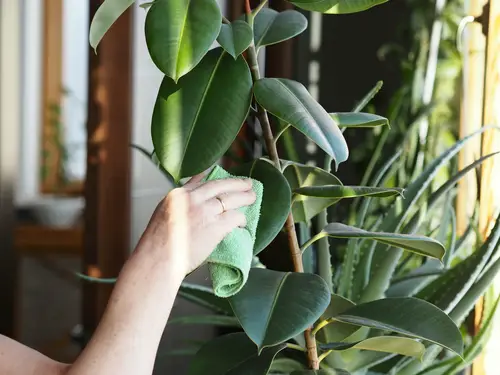Rubber plants are a popular choice for indoor gardening enthusiasts due to their attractive appearance and relatively low maintenance requirements. However, white spots on rubber plant leaves can be a cause for concern, as they may indicate a problem with the plant’s health.
Identifying the cause of white spots on rubber plant leaves is crucial to determine the appropriate treatment and prevent further damage. Common causes of white spots include diseases, pests, and environmental factors.
Oedema, a condition caused by overwatering or high humidity, can also lead to the formation of white spots on rubber plant leaves.
Key Takeaways
- White spots on rubber plant leaves can indicate a problem with the plant’s health.
- Identifying the cause of white spots is crucial to determine the appropriate treatment and prevent further damage.
- Common causes of white spots include diseases, pests, and environmental factors.
Also don’t miss:
- White Spots on Rose Bush Leaves
- Pumpkin Leaves with White Spots
- Plants Having Green Leaves with White Spots
Identifying White Spots on Rubber Plant Leaves
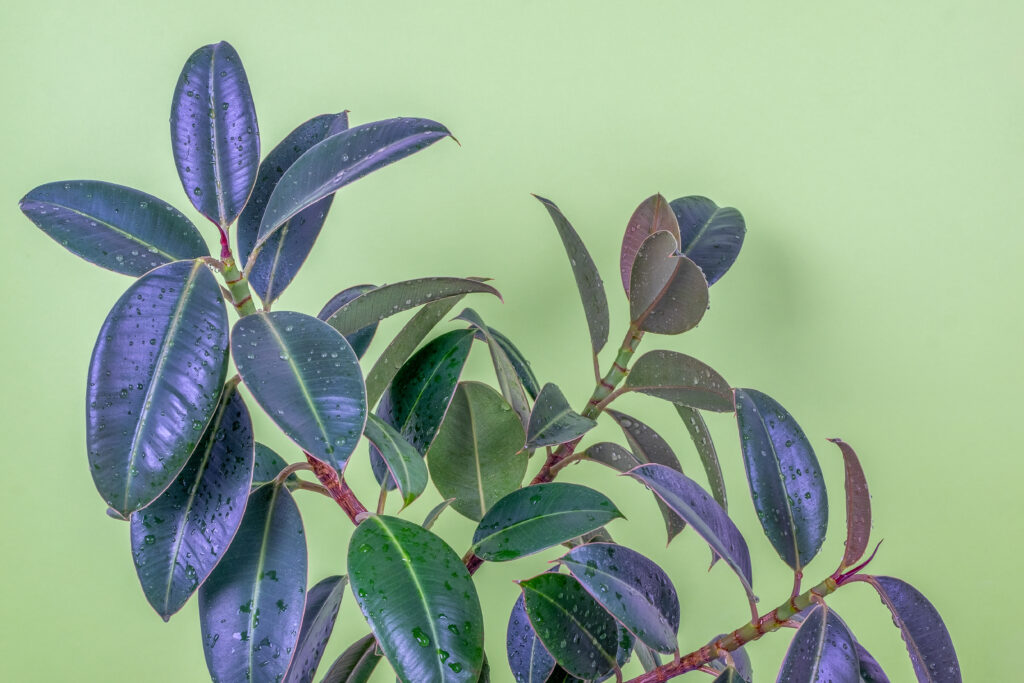
Rubber plants are popular houseplants known for their glossy leaves and easy maintenance. However, white spots on rubber plant leaves can be a cause for concern for plant owners. Identifying the cause of these white spots is crucial to restoring the health and beauty of the plant.
Disease or Pests
One possible cause of white spots on rubber plant leaves is a disease or pest infestation. Common diseases that can cause white spots include powdery mildew, leaf spot, and leaf blight. Pests such as spider mites and mealybugs can also cause white spots on rubber plant leaves.
To identify a disease or pest infestation, look for other signs such as discoloration, wilting, or webbing. Inspect the leaves and stem for any visible pests or signs of damage. If a disease or pest infestation is detected, it is important to treat the plant immediately to prevent further damage.
Sunburn or Overwatering
White spots on rubber plant leaves can also be caused by sunburn or overwatering. If the plant is placed in direct sunlight or exposed to high temperatures, the leaves can develop white spots. Overwatering can also cause white spots as it can lead to root rot, which affects the plant’s ability to absorb nutrients.
To prevent sunburn, move the plant to a shaded area or use a sheer curtain to filter the sunlight. To prevent overwatering, allow the soil to dry out before watering the plant again.
Edema or Mineral Deposits
Another possible cause of white spots on rubber plant leaves is edema or mineral deposits. Edema occurs when the plant takes in more water than it can transpire, causing the leaves to develop blisters or white spots.
Mineral deposits can also cause white spots on rubber plant leaves, especially if the water used for irrigation has a high mineral content.
To prevent edema, ensure that the plant is not overwatered and that the soil has good drainage. To prevent mineral deposits, use distilled or filtered water for irrigation.
Common Diseases Causing White Spots

Rubber plants are susceptible to various diseases that can cause white spots on their leaves. These spots can indicate malnutrition, disease, fertilizer issues, or frost damage. In this section, we will discuss some of the most common diseases that cause white spots on rubber plants.
1. Powdery Mildew
Powdery mildew is a fungal disease that appears as a white, powdery growth on the surface of the leaves. It can cause yellowing and curling of the affected foliage.
The disease is caused by a group of fungi that thrive in warm, humid conditions. Powdery mildew can be treated with a fungicide spray or by removing the affected leaves.
2. Root Rot
Root rot is a fungal disease that affects the roots of rubber plants. It can cause white spots on the leaves, as well as stunted growth, wilting, and yellowing of the foliage.
The disease is caused by overwatering or poorly drained soil, which creates a damp environment that promotes fungal growth. To prevent root rot, make sure to water your rubber plant only when the soil is dry to the touch and use well-draining soil.
3. Fungal Infections
Rubber plants are also susceptible to other fungal infections, such as downy mildew. This disease appears as yellow or white spots on the leaves, which can eventually turn brown and fall off. Fungal infections can be treated with a fungicide spray or by removing the affected leaves.
Pests that Cause White Spots
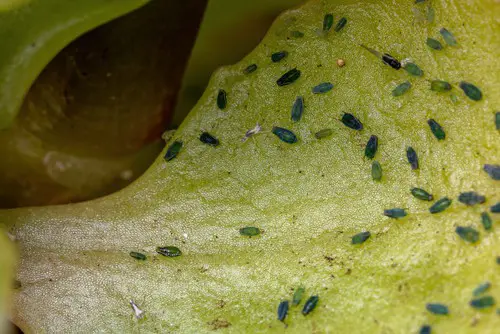
Rubber plants are susceptible to pests that can cause white spots on their leaves. Identifying the pest causing the problem is crucial to finding the right treatment. Here are some common pests that cause white spots on rubber plant leaves:
1. Spider Mites
Spider mites are tiny pests that are difficult to see with the naked eye. They are common in dry, hot conditions and can cause white spots on rubber plant leaves. These pests feed on the sap of the plant, causing the leaves to turn yellow and eventually fall off.
To prevent spider mites, ensure that the plant is well-hydrated and misted regularly. If spider mites are already present, use insecticidal soap or neem oil to get rid of them.
2. Mealybugs
Mealybugs are another common pest that can cause white spots on rubber plant leaves. They are small, white, and fluffy-looking insects that feed on the sap of the plant.
Mealybugs can be identified by their cotton-like appearance and the sticky residue they leave behind. To get rid of mealybugs, use a cotton swab dipped in rubbing alcohol to wipe them off the leaves. Alternatively, you can use insecticidal soap or neem oil.
3. Scale Insects
Scale insects are another type of pest that can cause white spots on rubber plant leaves. They are small, oval-shaped insects that attach themselves to the plant and feed on its sap.
Scale insects can be identified by their hard, protective shell that covers their body. To get rid of scale insects, use a cotton swab dipped in rubbing alcohol to wipe them off the leaves. Alternatively, you can use insecticidal soap or neem oil.
It is important to note that an insect infestation can weaken the plant and make it more susceptible to other problems such as fungal diseases. Therefore, it is crucial to identify and treat the problem as soon as possible.
Leafhoppers are another pest that can cause white spots on rubber plant leaves. However, they are less common than spider mites, mealybugs, and scale insects. If you suspect that leafhoppers are the cause of the problem, use insecticidal soap or neem oil to get rid of them.
Environmental Factors Leading to White Spots
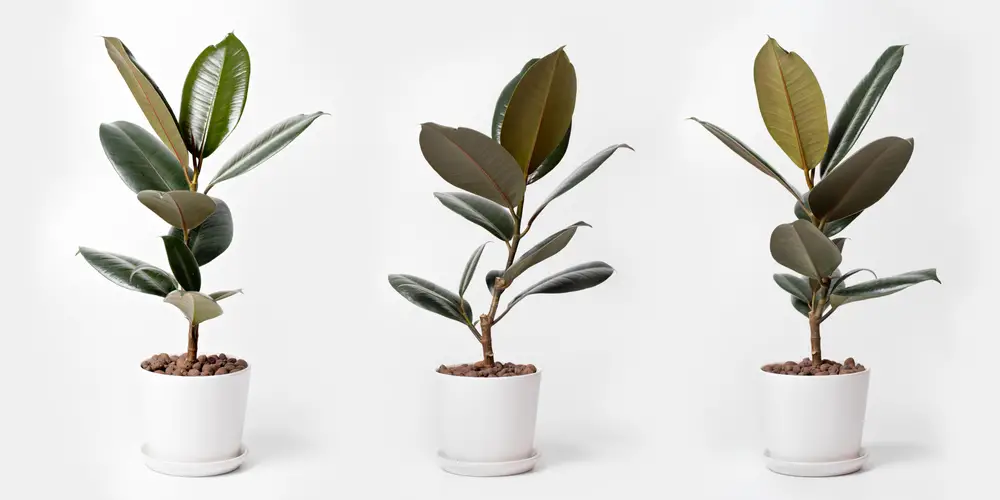
White spots on rubber plant leaves can be caused by various environmental factors. Understanding these factors is crucial in preventing and treating the issue. In this section, we will discuss the most common environmental factors that lead to white spots on rubber plant leaves.
Sunlight Exposure
Rubber plants require bright, indirect sunlight to thrive. Direct sunlight can cause sunburn, which results in white spots on the leaves. If your rubber plant is exposed to direct sunlight, it is important to move it to a location with bright, indirect sunlight.
Watering Practices
Overwatering is a common cause of white spots on rubber plant leaves. When the soil is too wet, the roots cannot absorb oxygen properly, leading to root rot. This can cause the leaves to develop white spots.
To prevent this, make sure to water your rubber plant only when the top inch of soil is dry. Also, make sure that the pot has proper drainage to allow excess water to escape.
Temperature and Humidity
Rubber plants prefer warm temperatures and high humidity. Cold temperatures and low humidity can cause the leaves to develop white spots. If your rubber plant is exposed to cold temperatures, move it to a warmer location. To increase humidity, you can place a humidifier near the plant or mist the leaves with water.
In addition to these factors, other environmental factors such as frost damage, too much water, and hard water can also cause white spots on rubber plant leaves. It is important to identify the underlying cause and take appropriate measures to prevent and treat the issue.
Treatment and Prevention of White Spots
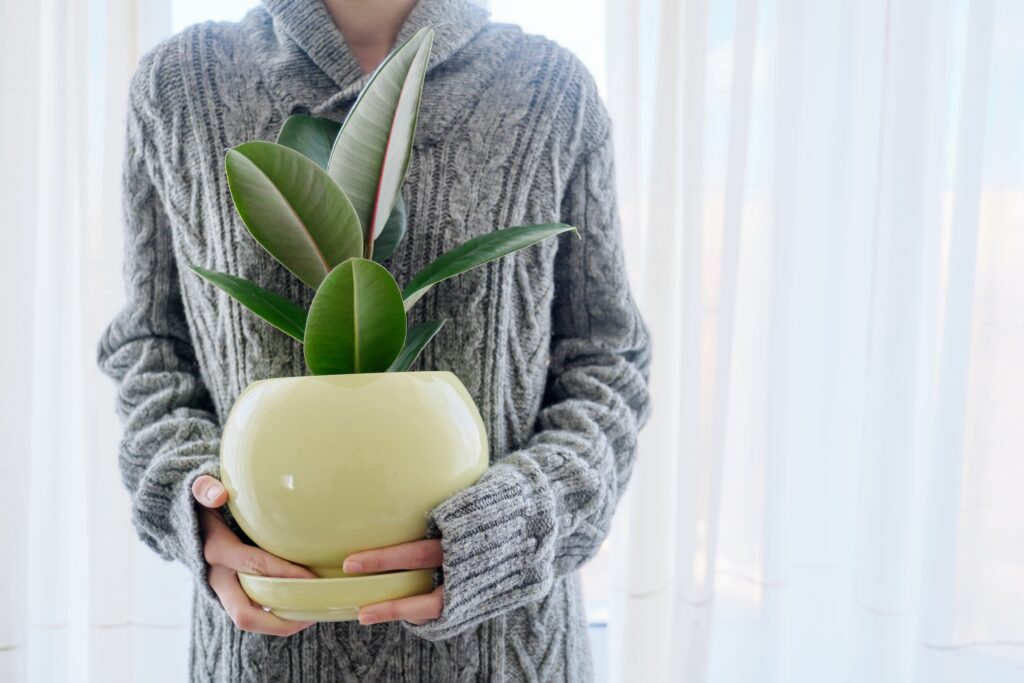
White spots on rubber plant leaves can be caused by various factors, including fungal infections, pests, and environmental stress. Fortunately, there are several treatments and preventive measures that can help restore and maintain the health and beauty of your rubber plant.
Chemical Treatments
When it comes to chemical treatments, fungicides, sulfur, copper sulfate, and bactericides can be effective in treating white spots caused by fungal infections and bacterial diseases. These chemicals work by killing the microorganisms responsible for the infection.
However, it is important to note that chemical treatments can be harsh on the plant and may have negative effects on the environment and human health. Therefore, they should be used as a last resort and only as directed by the manufacturer.
Natural Remedies
For those who prefer a more natural approach, neem oil and baking soda can be effective in treating white spots on rubber plant leaves. Neem oil is a natural insecticide and fungicide that can help control pests and fungal infections. Baking soda, on the other hand, can help prevent the spread of fungal spores.
To use neem oil, mix a few drops with water and spray the solution on the affected leaves. Repeat every 7-10 days until the white spots disappear. To use baking soda, mix a tablespoon with a gallon of water and spray the solution on the affected leaves.
Preventive Measures
Preventing white spots on rubber plant leaves is often more effective than treating them. Here are some preventive measures that can help keep your rubber plant healthy:
- Avoid overwatering the plant, as this can lead to root rot and other fungal infections.
- Ensure the plant is getting enough light, but avoid direct sunlight, which can cause sunburn.
- Maintain a consistent temperature and humidity level to prevent stress on the plant.
- Keep the plant clean by wiping the leaves with a damp cloth and removing any dead or diseased leaves.
- Quarantine any new plants to prevent the spread of pests and diseases.
Care for Healthy Rubber Plants
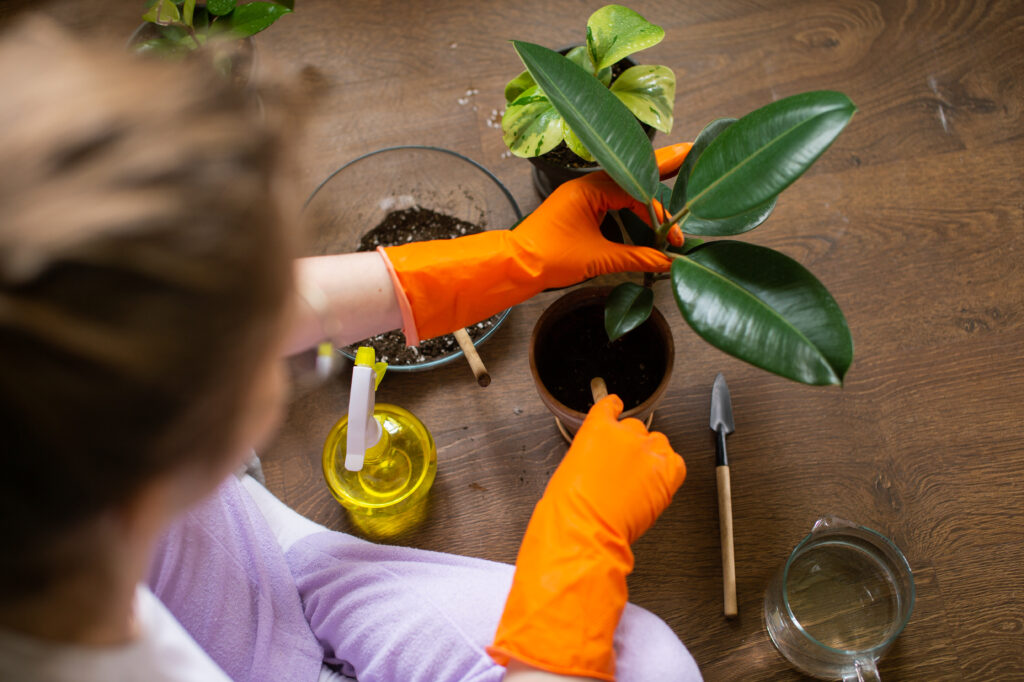
Rubber plants are low-maintenance houseplants that can thrive in most indoor environments. However, they still require some care to keep them healthy and looking their best. Here are some tips for taking care of your rubber plant.
1. Watering and Soil Requirements
Rubber plants prefer well-draining soil that is slightly moist but not waterlogged. Overwatering can cause root rot and other issues, so it’s important to let the soil dry out slightly between waterings. In general, rubber plants should be watered once a week during the growing season and less frequently during the winter months.
It’s also important to make sure that the pot has good drainage to prevent water from accumulating at the bottom. If the soil is consistently wet or the leaves are turning yellow, it may be a sign of overwatering.
2. Pruning and Repotting
Rubber plants can grow quite tall, so pruning may be necessary to keep them at a manageable height. Pruning can also help to encourage bushier growth and prevent the plant from becoming too leggy.
When repotting, choose a pot that is slightly larger than the current one and use well-draining soil. Rubber plants should be repotted every 2-3 years or when the roots start to outgrow the pot.
3. Fertilizing and Nutrition
Rubber plants are not heavy feeders, but they do benefit from occasional fertilization. Use a balanced fertilizer once a month during the growing season to provide the plant with the necessary nutrients.
In addition to fertilizer, rubber plants can also benefit from occasional dusting to remove any debris or dust that may accumulate on the leaves. This can be done with a soft cloth or a gentle spray of water.
Frequently Asked Questions
How do you get rid of white spots on rubber plants?
To get rid of white spots on rubber plants, it is important to first identify the cause of the problem. Some common causes of white spots include pests, fungal infections, and overwatering.
Once you have identified the cause, you can take appropriate action to treat the problem. For example, you may need to use an insecticide to get rid of pests, or adjust your watering schedule to prevent overwatering.
Why does my rubber plant have spots on the leaves?
Rubber plants can develop spots on their leaves for a variety of reasons, including pests, fungal infections, and nutrient deficiencies. It is important to identify the cause of the problem in order to treat it effectively.
If you are unsure what is causing the spots on your rubber plant, consider consulting a gardening expert or doing further research online.
What is the white stuff on my ficus leaves?
The white stuff on ficus leaves is likely a fungal infection, such as powdery mildew. This can be caused by a variety of factors, including high humidity, poor air circulation, and overwatering. To treat the problem, you may need to use a fungicide, adjust your watering schedule, or improve air circulation around your plant.
What do white spots on plant leaves mean?
White spots on plant leaves can indicate a variety of problems, including pests, fungal infections, and nutrient deficiencies. It is important to identify the cause of the problem in order to treat it effectively.
If you are unsure what is causing the white spots on your plant leaves, consider consulting a gardening expert or doing further research online.
Why is my rubber plant not growing new leaves?
Rubber plants may not grow new leaves for a variety of reasons, including insufficient light, overwatering, and nutrient deficiencies.
To encourage your rubber plant to grow new leaves, make sure it is getting enough light, adjust your watering schedule as necessary, and consider fertilizing your plant to ensure it is getting the nutrients it needs.
What are some common pests that affect rubber plants?
Some common pests that can affect rubber plants include spider mites, mealybugs, and scale insects. These pests can cause damage to your plant by sucking sap from the leaves and stems, and can also spread disease.
To prevent pest infestations, make sure your rubber plant is getting enough light and water, and consider using an insecticide if necessary.

Hey, I’m Lisa and I’ve been an avid gardener for over 30 years. I love writing, talking and living in the garden! Feel free to connect with me on my socials below

